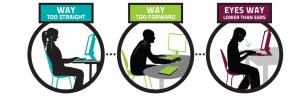
Address back pain during childhood to avoid a lifetime of suffering
World Spine Day – 16 October 2016
Musculoskeletal spinal pain (MSP) in children and adolescents has become a global health concern. The prevalence of MSP in children and adolescents has increased significantly in recent years and ranges between 15 and 35 percent.
"There is emerging evidence that children, especially adolescents who report persistent pain, are at increased risk of chronic pain as adults," said Dr Yolandi Brink, a physiotherapist at Stellenbosch University's Faculty of Medicine and Health Sciences.
The biggest risk factor for experiencing MSP in adulthood is the occurrence of a first episode of MSP during childhood or adolescence. "MSP is one of the most common causes of severe long term pain and physical disability," Brink said.
Attempts to understand these conditions at a time close to their initial onset may offer a better chance of developing effective prevention and treatment strategies. "Therefore the emphasis falls on either successfully addressing spinal complaints in the younger population or preventing that first episode of pain from occurring," Brink explained.
The cause of MSP - which includes neck, thoracic and lower back pain - in this population is multifactorial and can include lifestyle, physical, school-related as well as psychosocial factors.
Research has shown that the following are some issues associated with the presence of MSP:
- Physical factors such as age, gender, posture and duration of seated posture.
- Lifestyle factors such as physical fitness and nutrition.
- School-related factors such as backpack use and school furniture ergonomics.
- Psychosocial factors such as anxiety, depression and psychosomatic symptoms.
"However, whether these factors are true causal factors remains unknown. MSP conditions are often recurrent in nature, occurring throughout the life-course," Brink said.
Brink makes the following suggestions on how to avoid MSP in the younger population:
- Do not sit too straight, too forward or with your eyes lower than your ears. Avoid sitting with neck, thoracic and lumbar angles towards the end of the available range of movement.
- Children and adolescents should limit their time sitting as much as possible and specifically children should not engage in more than one hour of screen time (television and computers) per day and adolescents should not exceed two hours per day.
- Children and adolescents should be encouraged to participate in at least 60 minutes of physical activity or exercise daily. These activities should include vigorous activities at least three days per week and activities that strengthen muscle and bone at least three days per week.
- A well-balanced diet, which includes limiting the overconsumption of Vitamin B12, which is found in eggs, cereals and meat, is important.
- Children and adolescents should carry school backpacks which weigh less than 10 to 20 percent of their body weight and use wide padded shoulder straps over both shoulders. The duration of carrying the backpack should be limited.
- Lastly, therapeutic physical conditioning and manual therapy could be utilised to treat MSP in children and adolescents.
Media enquiries
Mandi Barnard
Marketing Coordinator
+27 (0)21 938 9505
Marketing and Communications Office
Faculty of Medicine and Health Sciences
Stellenbosch University
Website: www.sun.ac.za/health
Facebook: www.facebook.com/SUhealthsci
Twitter: @SUhealthsci
